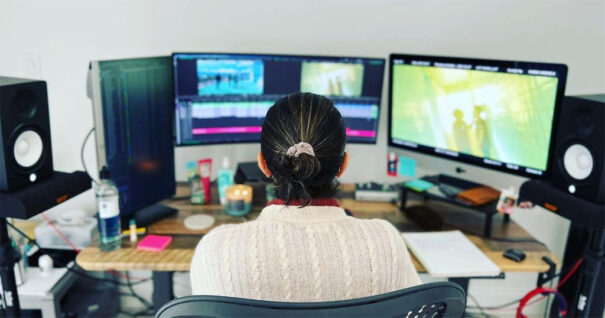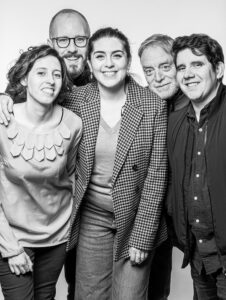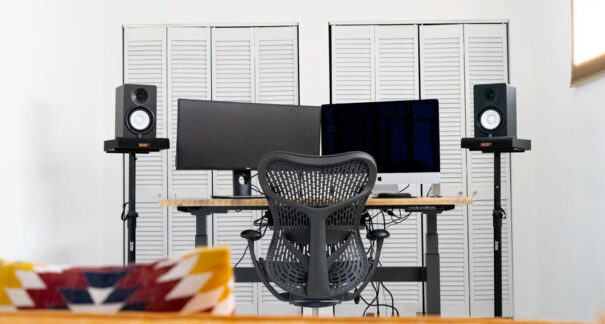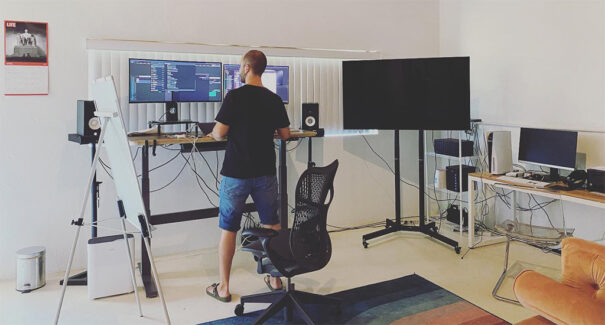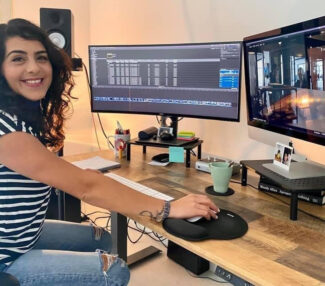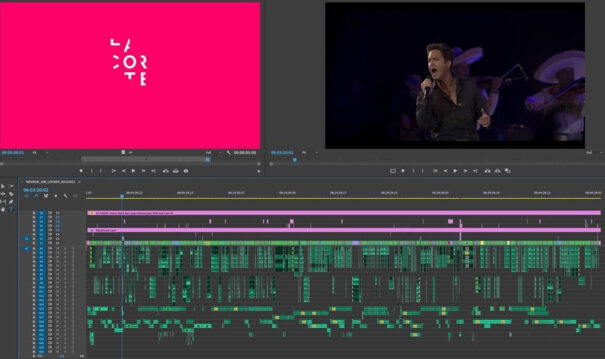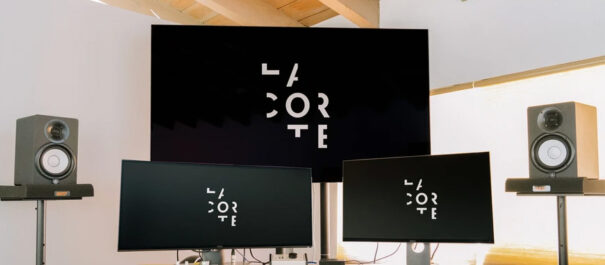Montage in the Age of Series: The Collaborative World of La Corte Editores
Sam Baixauli, Ana Castro y Alejandro Lázaro, socios y montadores del estudio de edición La Corte Editores, trasladan las nuevas claves del montaje en el siempre cambiante mundo de las plataformas de vídeo bajo demanda.
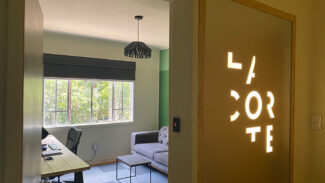 The montaje. Otrora trabajo solitario y una relación entre el editor y el director casi terapéutica (en tanto que ayudaba a solventar dudas y encontrar soluciones a un proyecto durante una fase crítica), hoy en día se abre a nuevos enfoques que redefinen su identidad. La tijera hace tiempo que se marchó, abriendo puertas a una era en la que el software, décadas después aún no exento de crasheos, continúa dando vida y sentido a historias, relatos y recuerdos.
The montaje. Otrora trabajo solitario y una relación entre el editor y el director casi terapéutica (en tanto que ayudaba a solventar dudas y encontrar soluciones a un proyecto durante una fase crítica), hoy en día se abre a nuevos enfoques que redefinen su identidad. La tijera hace tiempo que se marchó, abriendo puertas a una era en la que el software, décadas después aún no exento de crasheos, continúa dando vida y sentido a historias, relatos y recuerdos.
Como todo en esta vida, las cosas cambian. En esta ocasión, industrial y tecnológicamente. La llegada de las grandes plataformas con su músculo monetario, la apuesta por las series y el renovado impulso global de las producciones brindaron una nueva dimensión al producto predilecto de la pequeña pantalla. Series de amplia complejidad y larga duración debían estar disponibles al completo para calmar la creciente voracidad de un espectador que descubría el placer del binge-watching. Además, con enfoques diferentes sobre la naturaleza clásica del montaje, para llevar al cliffhanger a una nueva era (¡y creíamos que Twin Peaks or Lost habían sublimado este arte!) y volver a poner en boca de todos el FOMO.
En paralelo, el epítome de las catástrofes sociosanitarias hizo acto de presencia entre crisis y populismos, aún hoy, imparables. El entretenimiento audiovisual, en un mundo tan conectado como recluido, precisaba de nuevos métodos para seguir manteniendo viva su llama. Desarrolladores independientes y grandes corporaciones redoblaron sus esfuerzos para conducir a la industria de la postproducción a una nueva era cooperativa, en la que la ubiquidad se convertiría en un concepto capitular.
En este particular caldo de cultivo, repleto de oportunidades, un conjunto de profesionales de la edición decidió unir fuerzas para crear un estudio de edición colaborativo con su mirada puesta en las series, que, hoy, emplea a mas de 40 profesionales en hasta 10 producciones en paralelo. Consecuencia o respuesta a la transformación de la industria de la ficción televisiva, La Corte Editores es testigo de excepción de una transformación creativa, conceptual y tecnológica. Sam Baixauli, Ana Castro y Alejandro Lázaro, socios de la compañía con una amplia trayectoria profesional, brindan una visión transversal del mundo del montaje.
Dentro de La Corte
2017, CDMX. Bajo el sempiterno filtro de fotografía cálido que siempre acompañan las producciones de la capital mexicana (o no), un grupo de editores decide unirse para afrontar esta “nueva etapa en la que la industria iba a necesitar de equipos más grandes de trabajo”, recuerda Baixauli. Este conjunto de profesionales versados en largometrajes y publicidad vieron la oportunidad de crecimiento del mundo de las series, pero sabrían que solo podrían afrontarlo con todas las garantías uniendo fuerzas.
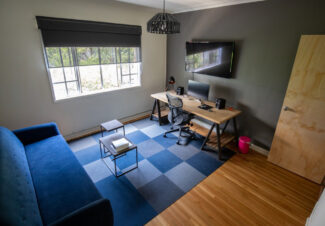 Con el objetivo de priorizar esa unión logística y personal entre los editores, dieron sus primeros pasos en una sede humilde en Ciudad de México para escalar hacia el mercado estadounidense y español con la apertura de una oficina en Miami (ya extinta), e instalaciones en Madrid and Barcelona. Esta expansión “orgánica y exponencial”, en palabras de Baixauli, se traduce en la actualidad a un equipo de 40 personas que escala hasta 60 profesionales en función de los proyectos en activo: “Más allá de los montadores, contamos con un equipo de organización de finanzas, producción, contabilidad y dirección técnica. Todos ellos dan soporte a aquello que priorizamos: el talento y creación de equipos de trabajo que se adaptan a cada proyecto”.
Con el objetivo de priorizar esa unión logística y personal entre los editores, dieron sus primeros pasos en una sede humilde en Ciudad de México para escalar hacia el mercado estadounidense y español con la apertura de una oficina en Miami (ya extinta), e instalaciones en Madrid and Barcelona. Esta expansión “orgánica y exponencial”, en palabras de Baixauli, se traduce en la actualidad a un equipo de 40 personas que escala hasta 60 profesionales en función de los proyectos en activo: “Más allá de los montadores, contamos con un equipo de organización de finanzas, producción, contabilidad y dirección técnica. Todos ellos dan soporte a aquello que priorizamos: el talento y creación de equipos de trabajo que se adaptan a cada proyecto”.
Netflix, Amazon Prime Video, HBO Max, Apple TV+, NBC Universal, Telemundo, El Estudio, Gato Grande Productions, Espotlight or Lemon Studios son solo algunos de los agentes del mercado que han apostado por la propuesta de La Corte Editores. Entre algunos de los títulos más destacados que han salido de sus estaciones de trabajo figuran nombres importantes en la producción de habla hispana como Luis Miguel: La serie, Hernán, La Reina del sur (temporadas 2 y 3), Marea Alta, Brigada Costa del Sol, Armas de mujer o la última producción exclusiva de Disney+ en España: Tú también lo harías.
 Al margen de estos servicios de montaje, Lázaro señala que la compañía está comenzando a ofrecer más y más servicios “llave en mano”, en los que las productoras confían en La Corte Editores para contratar soluciones globales. Para este tipo de proyectos, la compañía cuenta con una cartera de colaboradores entre los que figuran compañías y profesionales especializados en el color, el sonido o los efectos visuales: “En algunos casos hemos hecho casi una cata a ciegas: hemos encargado 10 minutos de metraje a tres coloristas diferentes para que el cliente final elija. Estamos muy abiertos a todo tipo de propuestas. No competimos a nivel de precio, sino en calidad de proyecto”, traslada Lázaro.
Al margen de estos servicios de montaje, Lázaro señala que la compañía está comenzando a ofrecer más y más servicios “llave en mano”, en los que las productoras confían en La Corte Editores para contratar soluciones globales. Para este tipo de proyectos, la compañía cuenta con una cartera de colaboradores entre los que figuran compañías y profesionales especializados en el color, el sonido o los efectos visuales: “En algunos casos hemos hecho casi una cata a ciegas: hemos encargado 10 minutos de metraje a tres coloristas diferentes para que el cliente final elija. Estamos muy abiertos a todo tipo de propuestas. No competimos a nivel de precio, sino en calidad de proyecto”, traslada Lázaro.
De la individualidad, al colectivo
Los inicios de La Corte Editores no fueron sencillos. La llegada de un concepto renovador en una industria en transformación aumentó la sensación de vértigo de los productores. Los primeros proyectos llegaron apoyados en experiencias pasadas e individualidades, tal y como confiesa Baixauli: “Los primeros clientes que tuvimos ya habían trabajado con Ana, Alejandro o Manu (Ndr: V. Manu Medina, socio) y sabíamos que se podían adaptar a este nuevo modelo”. Desde La Corte Editores sabían que su propuesta marcaba el mañana de la industria: “Para los proyectos que tenían entre manos sabían que iban a necesitar varios montadores. Tenían varias opciones: buscar a profesionales libres, o contar con un equipo de trabajo que ya sabe trabajar entre sí, va a dar una asesoría en ese sentido y tiene establecido un flujo interno creativo, logístico y tecnológico”.
Su manera de operar se ha mantenido con ligeras modificaciones desde su origen. Cada proyecto cuenta con dos figuras destacadas: lead editor, un “interlocutor creativo” que se encarga de dirigir al equipo de montadores (de hasta 15 personas por proyecto según sus requisitos específicos), y coordinador de la producción, responsable de funciones como el control de los materiales o la puesta en común de plazos.
“Todos los temores suelen llegar a la sala de montaje, por lo que tenemos que ver cómo resolverlos para sacar lo mejor de cada historia”.
Toda esta estructura, plena de interlocutores claros y procesos probados, tiene por objetivo que el cliente “se sienta protegido”. Baixauli se explaya en este concepto: “Cuando el cliente contacta con nosotros, llega tras haber trabajado durante muchos años en un guion, haber logrado vender una historia, peleado con sus propios clientes y superado rodajes, que siempre son procesos complicados. Por ello, nosotros queremos conseguir que sientan que su material está cuidado, bien revisado y analizado, y comprometernos con la historia que quieren contar. Todos los temores suelen llegar a la sala de montaje, por lo que tenemos que ver cómo resolverlos para sacar lo mejor de cada historia”.
Castro añade a las palabras de su compañero: “Utilizamos todo tipo de herramientas para tener siempre claro el big picture del proyecto. Lo más importante es el orden y la organización. Son dos elementos que hará que todo llegue a buen puerto”.
El montaje en la era del cliffhanger y el dato
Uno de los recursos que las plataformas de vídeo bajo demanda guardan con mayor recelo es su colección de datos. Auténticos tesoros, si bien frecuentemente enemigos de la creatividad, permiten conocer los hábitos del espectador para tratar de desentrañar la siempre esquiva fórmula del éxito: en qué momento el espectador se puede cansar, qué funciona en qué momento o cómo conseguir que diga “un capítulo más”. El tradicional focus group, pero con millones de inputs.
Al igual que el dato otorga pistas, también arrojasoluciones que afectan tanto a la escritura de los guiones como al montaje. Hoy en día, los cliffhanger, clásicos ganchos para mantener la expectativa sobre lo que está por venir, forman parte del día a día de La Corte Editores: “El cliffhanger puede enganchar sobre el papel, pero muchas veces no se aprecia en el rodaje. En edición, tenemos que inventárnoslo, hacer un flashback o pensar en diferentes maneras para crearlos”, traslada Castro, quien apunta, con cierta resignación, a una nueva forma de abordar cada proyecto: “Ahora todo es un crescendo tras otro. Me parece un poco desgastante, ya que muchas veces la prioridad de los montadores pasa a ser conseguir que el espectador se quede”. Esto, como el lector habrá podido confirmar en su plataforma de confianza, también se traduce en la reducción de la duración de los capítulos, con estrenos de drama que apuestan por una duración de 27 o 30 minutos.
“Ahora todo es un crescendo tras otro. Me parece un poco desgastante, ya que muchas veces la prioridad de los montadores pasa a ser conseguir que el espectador se quede”.
La búsqueda incansable del éxito de unas plataformas de vídeo bajo demanda cada vez más exigida por la extrema competencia y grandes inversiones se traslada, como apuntan numerosas voces en el mercado, en una creciente falta de creatividad. Así lo expresa Baixauli: “Cuando empezó todo esto, siento que había más margen para la exploración. Había menos bases de datos acumuladas y, por tanto, más desconocimiento, lo que hacía que hubiera más apertura hacia la creatividad (…). Ahora, si bien hay showrunners y productores ejecutivos que siguen defendiendo la naturaleza del proyecto, se analizan y valoran todas las posibilidades, lo que limita las opciones en el proceso de edición”.
Redes: sustento de la colaboración
El auge de los flujos remotos, una de las escasas notas positivas de la pandemia, reafirmo el axioma fundacional de La Corte Editores. Aquellos procesos iniciales fruto de la supervivencia ya forman parte del día a día de la compañía, que utiliza diversas herramientas para su operación diaria.
La base de su propuesta es la construcción de una red que interconecta los servidores que almacenan todo su trabajo en sus tres sedes: Madrid, Barcelona y Ciudad de México. Esta interconexión accesible vía VPN con un importante firewall proporcionado por Culm Meraki permite a los editores trabajar presencialmente desde cada una de las ubicaciones con todas las medidas de seguridad exigidas por sus clientes.
A pesar de esta interconexión transoceánica, el verdadero músculo de procesamiento y operabilidad se sustenta en equipos locales, no en soluciones cloud o virtualizadas. No obstante, Lázaro tiene claro que la nube será el siguiente paso para sus operaciones: “Todos vamos a ir hacia un almacenamiento masivo en la nube. Tanto Netflix como Amazon Prime Video se dirigen a constituirse como una especie de content hub para edición aprovechando sus apuestas por la nube”. Quizá esta filosofía cloud también llegue a las workstation de La Corte, ya que como el propio Lázaro confiesa entre risas: “Ya nos hemos arruinado varias veces comprando máquinas y no es nuestra intención hacerlo otra vez”.
“Todos vamos a ir hacia un almacenamiento masivo en la nube. Tanto Netflix how Amazon Prime Video se dirigen a constituirse como una especie de content hub for edition aprovechando sus apuestas por la nube”
Por ahora, entre los equipos de trabajo destacan varios Mac Mini con procesador M2 y M1, que arrojan un rendimiento más que solvente para sus flujos de trabajo, frecuentemente a 2K. Trabajando con codificación H.265 y HDR, el siguiente paso será el UHD: una evolución natural, en palabras de La Corte, pero no estrictamente necesaria para su operabilidad diaria.
Mientras que la colaboración externa se realiza con herramientas como Evercast, el flujo de trabajo colaborativo interno se suele beneficiar del editor Premiere Pro. Conectado a la red interna de La Corte Editores y beneficiándose de la herramienta Productions integrada en el software de Adobe, “hasta 15 o 20 editores pueden trabajar simultáneamente en el mismo proyecto”.
El software de edición: ¿cambio de paradigma?
Más allá de Adobe Premiere Pro, La Corte Editores también trabaja frecuentemente con Avid Media Composer, Final Cut Pro y el módulo de edición de DaVinci Design.
 Esta amplitud de opciones se ofrece con libertad a los diferentes profesionales que integran el conjunto de La Corte. Sin embargo, el día a día evidencia preferencias. Final Cut Pro apunta a ser usado cada vez menos por el “creciente abandono” de este sistema por parte de Apple para producciones profesionales de primer nivel, en palabras de Lázaro. Por otro lado, Avid Media Composer sigue ocupando una posición destacada en el día a día de La Corte, si bien su integración con el sistema Nexis limita su aplicación en diferentes proyectos. De hecho, Baixauli afirma que muchos de los proyectos que se abordan con la solución de Avid en la casa son “heredados” de otros procesos de edición que no han tenido, en opinión de la producción ejecutiva y dirección, el acabado idóneo.
Esta amplitud de opciones se ofrece con libertad a los diferentes profesionales que integran el conjunto de La Corte. Sin embargo, el día a día evidencia preferencias. Final Cut Pro apunta a ser usado cada vez menos por el “creciente abandono” de este sistema por parte de Apple para producciones profesionales de primer nivel, en palabras de Lázaro. Por otro lado, Avid Media Composer sigue ocupando una posición destacada en el día a día de La Corte, si bien su integración con el sistema Nexis limita su aplicación en diferentes proyectos. De hecho, Baixauli afirma que muchos de los proyectos que se abordan con la solución de Avid en la casa son “heredados” de otros procesos de edición que no han tenido, en opinión de la producción ejecutiva y dirección, el acabado idóneo.
Desde la otra perspectiva, Premiere Pro se erige como la opción de preferencia de La Corte Editores por su “facilidad, accesibilidad y opciones colaborativas”. De hecho, Baixauli denota un cierto estigma contra la herramienta de Adobe en España que se suele disipar en el momento en el que los colaboradores comprueban el correcto funcionamiento de las herramientas colaborativas y de control que integra el software. Finalmente, el módulo de edición de DaVinci Resolve recibe una mención especial por parte del equipo de La Corte: todo apunta a que su futuro se dirigirá cada vez más hacia esta herramienta desarrollada por Blackmagic Design.
La promesa de la IA en el montaje
“Todo el mundo está ahora un poco paranoico con el mundo de la IA”, comenta entre miradas cómplices con sus compañeros Lázaro. Sin embargo, inmediatamente después, su compañero Baixauli procede a exponer con cierta ilusión muchas de las puertas que podrían abrir: “Estoy convencido de que va a hacer los procesos mucho más ágiles y será muy útil para determinados proyectos”.
Estas primeras soluciones para el mundo de la edición, desarrollos open-source, procesos integrados en los softwares de edición o creaciones de empresas independientes, prometen simplificar procesos como la catalogación de clips, la sincronización, la organización por bloques o los primeros armados, así como mejorar herramientas ya establecidas como la transcripción de audio a texto, la eliminación de ruido or la detección de píxeles muertos. En La Corte Editores ya aplican varias de estas herramientas, e incluso están haciendo pruebas para la creación asistida de títulos de crédito.
“Estoy convencido de que la IA va a hacer los procesos mucho más ágiles y será muy útil para determinados proyectos”.
Todos estos procesos son de mera asistencia; una ayuda útil que elimina procesos tediosos, pero que no son capaces, por ahora, de construir narrativas e historias. Ese es, según Lázaro, lo que evidencia el valor la figura del editor. Lejos de tecnologías, máquinas y nuevas revoluciones, las people serán marcando la diferencia en La Corte Editores: “Nuestro valor no está en el hardware o en el software, sino en el talento individual de las personas que contratamos. De hecho, en nuestra web no mostramos nuestras máquinas, sino los proyectos y nuestra gente. Ese es, realmente, nuestro capital”.
A report by Sergio Julián Gómez
Did you like this article?
Subscribe to our NEWSLETTER and you won't miss a thing.



